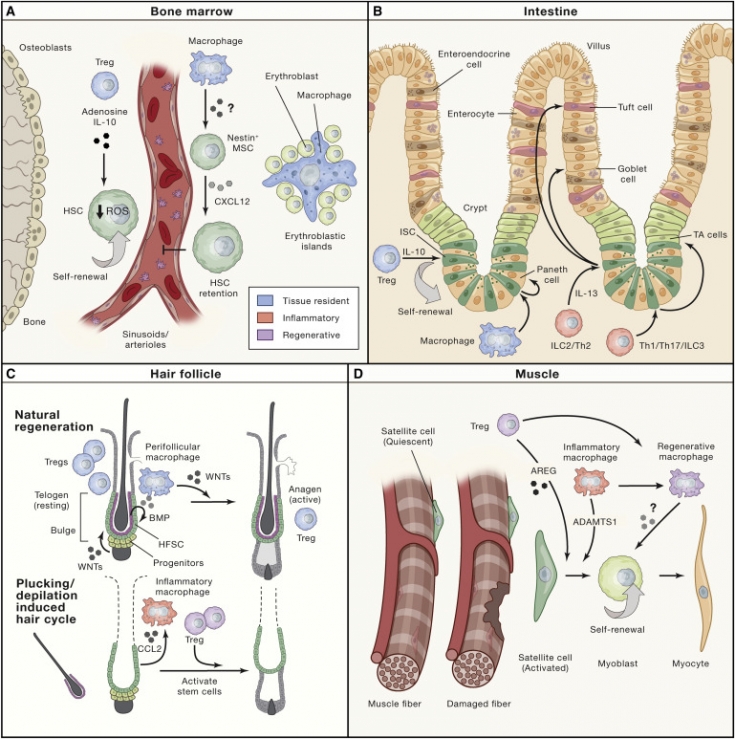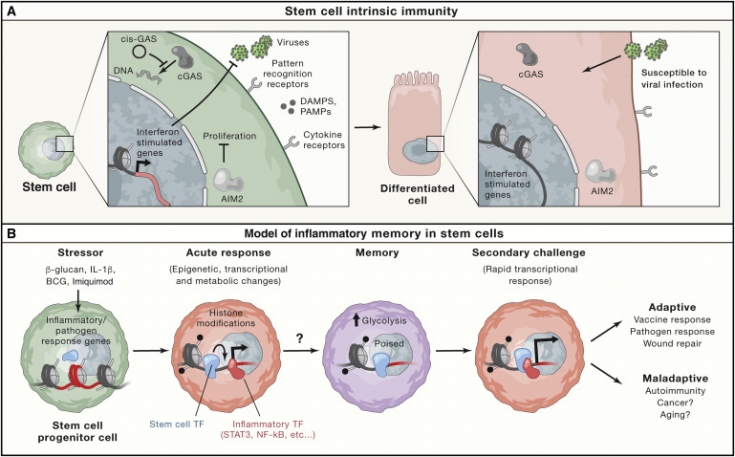Tissue aging is typically manifested by increased levels of pro-inflammatory mediators, systemic inflammation, and impaired wound healing.
Recent studies indicate that some of these age-related defects are due to a lack of coordination between immune cells and tissue stem cells and/or the accumulation of pro-inflammatory mediators in the tissue.
Read in the estet-portal.com article about the interaction between stem cells and senescent epithelial cells, which is the key to unraveling the mechanisms of aging.
Molecular causes of skin aging

Mouse skin offers an interesting ecosystem to study, as it has a unique population of .gamma;.delta. T cells called dendritic epidermal T cells (DETCs) that orchestrate wound repair.
When injured, epidermal progenitors upregulate the expression of the Skint genes, which are essential to prevent DETCs. In turn, DETCs release keratinocyte growth factor and insulin-like growth factor to stimulate proliferation of the epidermal progenitor and promote healing.
In aging skin, this communication network breaks down, and as a result, epidermal progenitors are forced to re-epithelize without the help of DETCs.
Follow us on Instagram
Although the human epidermis does not have DETCs, similar disruptions in the dialogue between other resident T cells and stem cells may underlie chronic wounds in the elderly.
Role of accumulation of pro-inflammatory factors in skin aging
In addition to dealing with disturbances in their communications with resident immune cells, senescent stem cells also experience an accumulation of inflammatory mediators, leading to their functional decline.
In the skin, the proliferative capacity of hair follicle stem cells decreases, as well as their ability to regenerate hair. Remarkably, blocking the inflammatory response is enough to reverse proliferative defects in these stem cells. Indeed, in a number of cases in vitro and in vivo, old stem cells exhibit an altered proliferative or differentiating ability. In these situations, the accumulation of pro-inflammatory factors invariably leads to tissue dysmorphia and functional decline.
The key to reversing aging lies in the suppression of inflammatory mediators.
These include target flooding with anti-inflammatory mediators and increased expression of immunosuppressive molecules. For example, in the bone marrow, regulatory T cells (Tregs) produce the immune suppressor cytokine IL-10 near hematopoietic stem cells (HSC) to limit inflammatory stress in their niche.
Benefits of Stem Cells in Aging Skin
The epithelial tissues that line our bodies have developed particularly sophisticated means of protecting their stem cells. The hair follicle stem cell niche has a low level of immunoactivating molecules and a high amount of Tregs.
Information about the role of Tregs is available in the article Causes of baldness: scientists have discovered new aspects at the cellular level
In a recent study by Wu et al. (2018) found that stem cells are hardwired to express antiviral interferon-stimulated genes (ISG) that help them fight viral infections.
Although the exact means by which stem cells maintain high ISG expression is unclear, a role for the PAMP and DAMP receptor array is implied and may be responsible for ISG amplification. In the case of active viral infections, mesenchymal stem cells can activate ISG by detecting infection through the cytosolic double-stranded (ds) viral DNA probe cGAS.

By having a memory of an acute inflammatory attack, epithelial stem cells are better able to cope with subsequent barrier disruptions: epidermal stem cells remodel their chromatin after an acute inflammation. In a secondary inflammatory response, such as injury, these experienced stem cells rapidly regulate by transcribing available chromatin domains. A key mediator of this memory is the inflammatory activator AIM2, which enhances IL-1β to promote recovery after injury.
Thus, the mechanisms of aging are due to a violation of the coordination of the work of stem cells and cells of the immune system, the accumulation of pro-inflammatory factors. However, the use of anti-inflammatory factors can stop the aging process, and the accumulated experience of "meeting" stem cells with pathogens allows you to improve defense mechanisms without resorting to the help of the immune system.
Thank you for staying with estet-portal.com. Read other interesting articles in the "Cosmetology" section. You may be interested in How to slow down skin aging: epigenetic possibilities of cosmetology
Cell







Add a comment